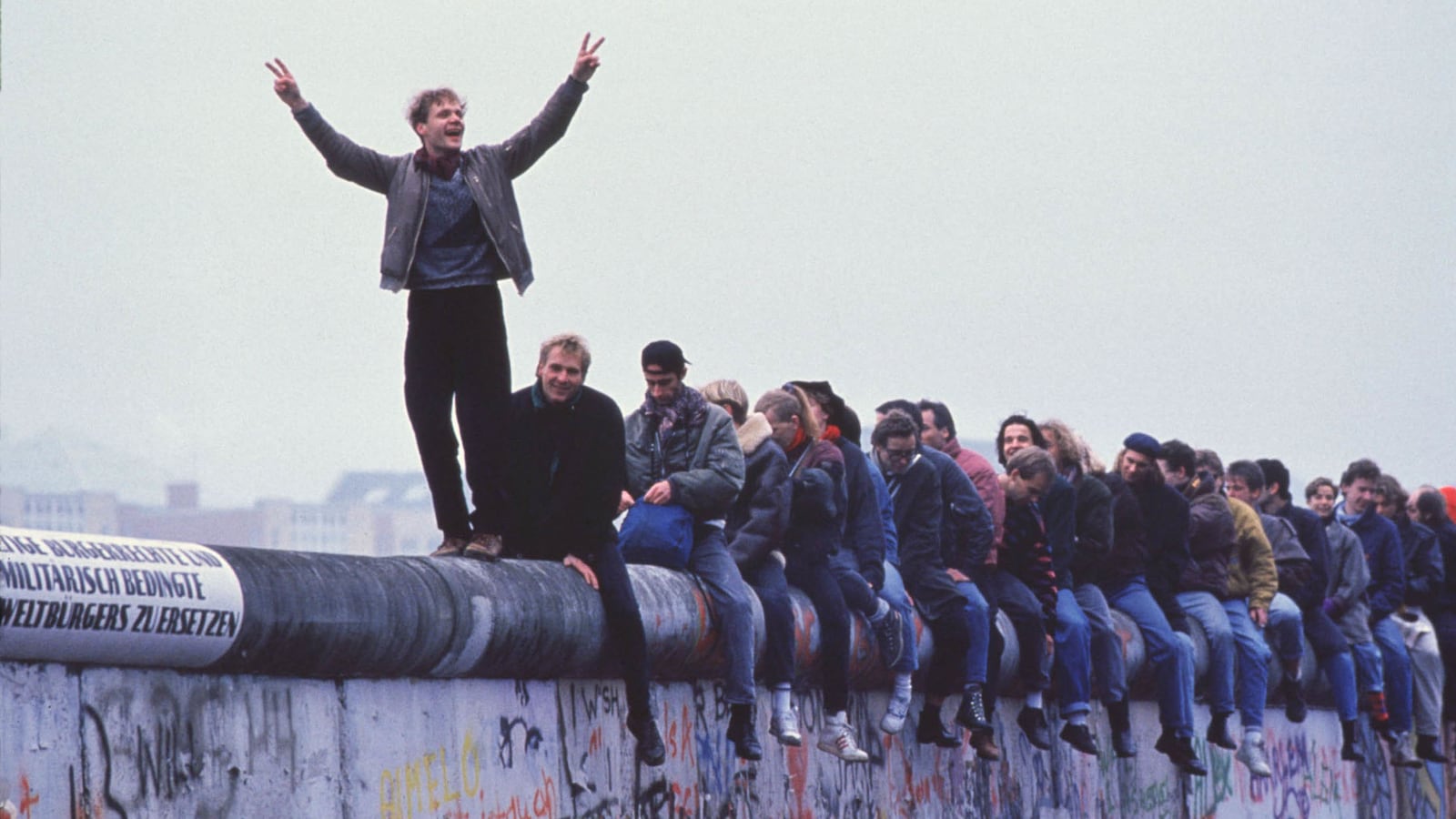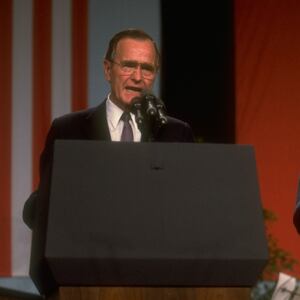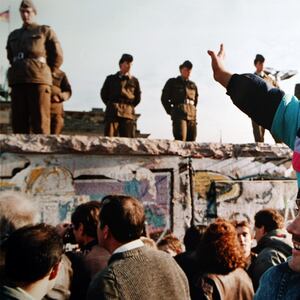Most people know that the storming of the Bastille triggered the French Revolution, the assassination of Austria’s Archduke Ferdinand in Sarajevo triggered World War I, and the fall of the Berlin Wall on Nov. 9, 1989, exactly 30 years ago, triggered the collapse of communism in Europe, ending the Cold War division of the continent and the world.
But to understand any of those events requires a knowledge of what came before and what came after, and in the case of the Wall, an event of the past that continues to influence the present, that context is essential.
The collapse of the Soviet-imposed communist system in half of Europe cannot be reduced to a singular event on a single day, however spectacular it was. The iconic images of East and West Germans climbing up on the Berlin Wall and hammering away at the hated structure are so powerful that they have overshadowed the other dramas of 1989 that made that moment possible. They also fail to account for where this event fits into the larger narrative of the convulsions of that era.
The destruction of the Soviet empire in Eastern Europe began earlier that year in Poland and Hungary, and continued after the fall of the Wall with new upheavals in Czechoslovakia and Romania, leading soon thereafter to the implosion of the Soviet Union itself. The fall of the Berlin Wall was not the beginning of the collapse of communism: it was the pivotal third act in a classic five-act play. That in no way diminishes its importance—in fact, it highlights its central role in the drama.
Consider the prelude to 1989, which set the stage for the ensuing events. There was the pent-up frustration of the people of the region who were trapped in a failed economic system where everything, from housing to basic foodstuffs, was in chronic short supply, and the contrast with the prosperous West was glaringly evident. Every gap between East and West was widening: the technology gap, the productivity gap, the life-expectancy gap. East Germans could see this on a daily basis just by switching their TVs to West German channels.
Czechoslovakia, which ranked among the top 10 industrialized nations when it was founded in 1918, found it increasingly difficult in the 1970s and 1980s to compete in Western markets with its shoddy manufactured goods. Prime Minister Lubomir Strougal privately joked to Western delegations that a sign stood on the country’s border: “Welcome to the Museum of the Industrial Revolution.”
Yet the communist governments loudly insisted that their subjects were living in states that embodied socialist ideals, and the mere act of pointing out their lies and absurdities risked instant punishment. Earlier uprisings—in East Germany in 1953 and Hungary in 1956, along with Czechoslovakia’s attempt to introduce “socialism with a human face” in 1968—were crushed by Soviet tanks, while successive waves of strikes and protests in Poland met with local crackdowns.
By the late 1970s and early 1980s, a new generation of activists from various groups—Solidarity in Poland, Charter 77 human rights campaigners in Czechoslovakia, the “democratic opposition” in Hungary—had emboldened more people to challenge the communist system at every turn. Dissidents like Czech playwright Vaclav Havel, who would become the first president of his newly liberated country, talked compellingly about the “radioactivity” of words in a totalitarian state. “When free speech is suppressed, speech paradoxically has a special weight and power,” he explained to me when I first visited him in 1986.
Similarly, Polish activist Adam Michnik urged his countrymen to live according to the credo “freedom is self-creation.” Both men spent long periods behind bars for acting upon such beliefs by refusing to remain silent, but their example—and those of so many others—proved contagious.
So did the words flowing from new leaders. The elevation of John Paul II to the papacy in 1978 meant that the Vatican was home to a Polish leader whose calls for social justice and to speak the truth dovetailed perfectly with the dissident credo. It was no accident that the free trade union Solidarity was born in his homeland shortly thereafter.
The new U.S. president, Ronald Reagan, dared to talk about the Soviet “evil empire,” calling for the Berlin Wall to be torn down at a time when most Westerners were convinced this was an impossibility. In the Kremlin, Mikhail Gorbachev firmly believed he could save the communist system by reforming it and promising an end to violent repression.
What the new Soviet leader failed to understand was that, without the threat of Soviet tanks rolling in again, popular discontent in Eastern Europe could no longer be contained. The people of the region no longer believed in reforming the current system. “Nobody is for socialism,” a Polish sociology student told me in 1988 as a new round of strikes broke out. A popular joke making the rounds asked: “What is the relationship between democracy and socialist democracy?” The answer: “The same as between a chair and an electric chair.”
By early 1989, the near collapse of the Polish economy and rising political discontent produced Act One of that year’s drama. Gen. Wojciech Jaruzelski, the strongman who had declared martial law in 1981 and outlawed Solidarity, suddenly reversed himself and agreed to negotiate with the movement’s leaders. By April, this produced an accord permitting partially free elections, whereby Solidarity was allowed to contest a minority of the seats in parliament. The communist authorities were convinced this would appease the population while keeping power in their hands.
But introducing a small dose of democracy while maintaining a dictatorship was, as Poles pointed out, akin to trying to remain a little bit pregnant. In the June 1989 voting, the opposition won 260 of 261 contested seats by landslide margins, prompting two small pro-government parties to defect to their side. That tipped the political balance, producing the first noncommunist government in the Soviet bloc, sending shock waves across the region.
Act Two was set in Hungary, where the country’s communist rulers had long tried to portray themselves as reformers and now felt added pressure to demonstrate that they were changing with the times. Following the Polish breakthrough, the Hungarian leaders opened their border with Austria, ostentatiously beginning to take down the barbed-wire fences that separated the two countries. Since Hungarians had been able to travel freely to Austria for a decade, this was primarily a symbolic gesture for them, aimed at proving that Hungary was no longer imprisoned in the Soviet bloc.
Nonetheless, this marked the beginning of the end of the Iron Curtain—and of the isolation of East Germany. East Germans were allowed to visit Hungary and other “fraternal socialist countries,” and they quickly discovered they could freely cross the Hungarian-Austrian border, prompting a mass exodus. Despite furious protests by East German leader Erich Honecker, the Hungarians refused to plug this gaping hole. Honecker’s regime could only survive so long as the exits for its citizens were blocked, and this was no longer the case.
Back in East Berlin, popular pressure and protests kept building. On Nov. 9, four days after a rally that attracted half a million people, the disoriented and panicked East Germany’s authorities decided to relax the travel rules for its citizens–but not to abolish them immediately. But when Günter Schabowski, the regime’s spokesman, read from hastily prepared notes that had been handed to him about the new measures, he conveyed the impression that all restrictions were lifted. East Berliners were not about to wait for any clarifications: a growing number headed for the crossings between East and West Berlin.
Up to that point, the East German border guards had not hesitated to use force to stop anyone trying to get across or through the Berlin Wall, and would shoot them when all else failed. But they, too, had heard Schabowski’s statements and were not sure what to make of them. And they were vastly outnumbered by the crowds gathering in front of them.
Harald Jäger, one of the guards who was in charge that day, desperately tried to get instructions from his superiors. But no one was interested in telling him anything. Faced with the choice of either trying to stop the people or giving way at his border crossing, Jäger recognized that any effort to use force would be both disastrous and futile. As he recalled in an interview with Der Spiegel in 2009, “People could have been injured or killed even without shots being fired, in scuffles, or if there had been panic among the thousands gathered at the border crossing. That's why I gave my people the order: Open the barrier!”
What happened next was played over and over again on television screens across the globe: both Easterners and Westerners hoisted themselves atop the Wall, embracing, drinking, singing and rushing in with pickaxes, hammers and any other tools at hand to start hacking away at the despised barrier. Thousands of East Germans streamed into West Berlin, a city symbolizing the freedom that had been so close yet so unreachable until then. The fear that had once kept them out had suddenly evaporated. Their putative rulers had been completely overtaken by the rush of events.
Act Four took place in December 1989, when the “Velvet Revolution” led by Havel and others toppled the hardline regime in Prague, and Romanian tyrant Nicolae Ceausescu was overthrown in the one violent uprising of that year, ending with his summary execution and that of his equally despised wife.
In the immediate aftermath of all this, the former dissidents marveled about the abrupt turnabout in their countries’—and their personal—fortunes. Both Havel and Poland’s former Solidarity leader Lech Walesa were soon elected president of their respective nations.
A few months after his inauguration, Havel mused that he could not quite believe what had happened. “I am the kind of person who would not be surprised if, in the very middle of being president, I were to be summoned and led off to stand trial before some shadowy tribunal, or taken straight away to the quarry to break rocks,” he declared. “Nor would I be any more surprised if I were suddenly to hear the reveille and wake up in my prison cell, and then, with great bemusement, proceed to tell my fellow prisoners everything that happened to me in the past six months.”
Any return to the past was soon ruled out by Act Five, the collapse of the Soviet Union in late 1991. Gorbachev was convinced that he could allow the countries of Eastern Europe more leeway while keeping the “near abroad”—the Soviet republics such as the Baltic states and Ukraine—satisfied with piecemeal reforms. He satisfied no one, and activists in those republics demanded full independence. It was impossible to arrest the momentum for radical change unleashed in 1989.
It wasn’t just political and concrete barriers that were breached; it was also the psychological barriers that had served to convince a large part of the population under communist rule that they had no way of influencing events. Once the first political breakthroughs took place, the psychological barriers gave way with stunning speed.
Jiri Dienstbier, a former journalist who had been banned from his profession because of his political activism in Prague, recalled how Havel appointed him foreign minister in December when he was still making a living stoking furnaces. In December 1989, he exchanged that grimy subterranean world for his new office in the foreign ministry, a Baroque 17th-century palace on Prague’s majestic Castle Hill. “There was something absurd in it,” he told me on my first visit to his new office.
But he and others quickly became accustomed to such breathtaking turnabouts because they understood what an artificial construct the old order was. Dienstbier explained that he always felt that the dissident label was misapplied to him and his fellow activists. “I always resisted that word,” he said, adding about the communists: “I felt they were the dissidents.”
Or, as a bit of Prague graffiti put it, referring to the communist regime’s “normalization” campaign that had tried to stamp out all opposition: “They tried to normalize us, but we were normal all the time.”
It was only fitting that the rediscovery of that normality led to the destruction of the most abnormal physical monstrosity in the heart of Europe, the Berlin Wall. At long last, the region’s inhabitants emerged from its long shadow.








